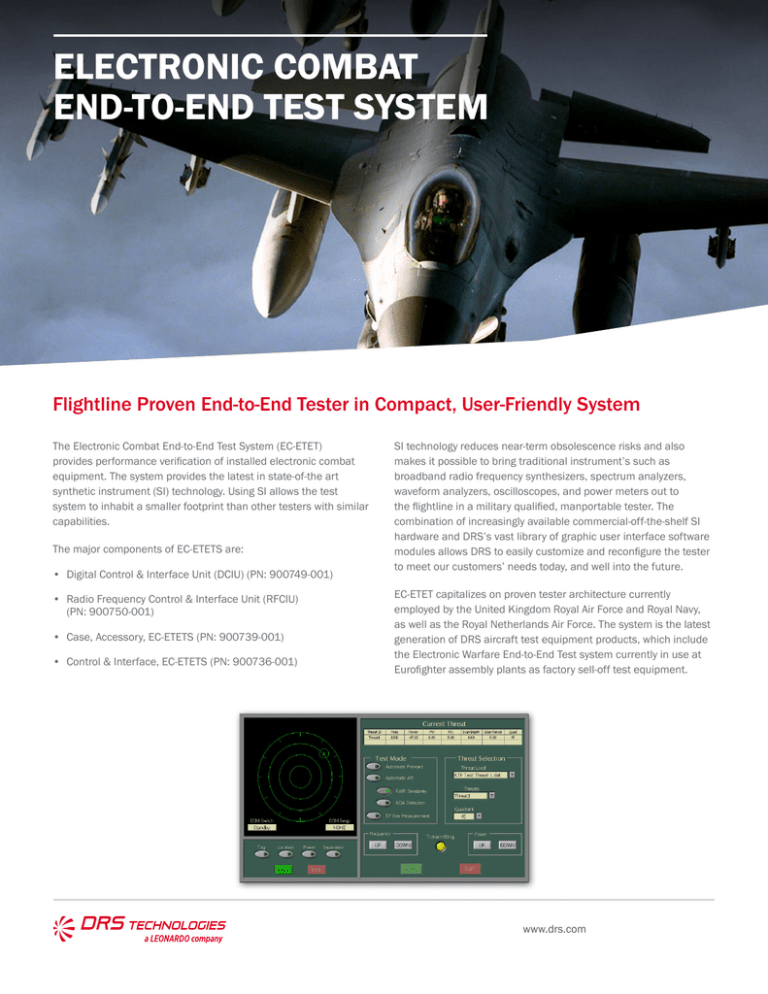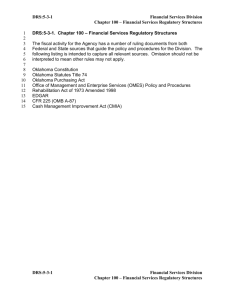
ELECTRONIC COMBAT
END-TO-END TEST SYSTEM
Flightline Proven End-to-End Tester in Compact, User-Friendly System
The Electronic Combat End-to-End Test System (EC-ETET)
provides performance verification of installed electronic combat
equipment. The system provides the latest in state-of-the art
synthetic instrument (SI) technology. Using SI allows the test
system to inhabit a smaller footprint than other testers with similar
capabilities.
The major components of EC-ETETS are:
• Digital Control & Interface Unit (DCIU) (PN: 900749-001)
• Radio Frequency Control & Interface Unit (RFCIU)
(PN: 900750-001)
• Case, Accessory, EC-ETETS (PN: 900739-001)
• Control & Interface, EC-ETETS (PN: 900736-001)
SI technology reduces near-term obsolescence risks and also
makes it possible to bring traditional instrument’s such as
broadband radio frequency synthesizers, spectrum analyzers,
waveform analyzers, oscilloscopes, and power meters out to
the flightline in a military qualified, manportable tester. The
combination of increasingly available commercial-off-the-shelf SI
hardware and DRS’s vast library of graphic user interface software
modules allows DRS to easily customize and reconfigure the tester
to meet our customers’ needs today, and well into the future.
EC-ETET capitalizes on proven tester architecture currently
employed by the United Kingdom Royal Air Force and Royal Navy,
as well as the Royal Netherlands Air Force. The system is the latest
generation of DRS aircraft test equipment products, which include
the Electronic Warfare End-to-End Test system currently in use at
Eurofighter assembly plants as factory sell-off test equipment.
www.drs.com
ELECTRONIC COMBAT END-TO-END TEST SYSTEM
FULL RANGE OF TESTING
The tester allows the operator to run different test setups and
scenarios in order to verify system operational status. Radar
warning receivers and electronic countermeasures system
performance is fully tested, including antennas, transmission
lines, radomes, cockpit displays, system communication buses.
Selectable, non-intrusive testing can be fully automatic,
semi-automatic or manual. Test capabilities include:
• Sensitivity
• Power
• Selectivity
• Frequency
• System response to stimulus
• Rise/fall times
• Return loss/Voltage Standing • Amplitude
Wave Radio
• Duty cycle
• Insertion loss
• Pulse repetition
• Distance to fault interval
• Electronic countermeasures
• Pulse width
technique analysismeasurements
USER–FRIENDLY TEST PROGRAM SETS
DRS has over 50 years experience successfully integrating
and developing electronic warfare (EW) avionics test program
sets. DRS uses graphical user interface-based software like
National Instruments LabVIEW to develop and field userfriendly operations-level test programs. As a commercial-offthe-shelf (COTS) programming environment, LabVIEW ensures
the customer of a non-proprietary test program that can be
organically maintained with little training, thereby reducing
total cost of ownership. DRS has an existing library of over
300 application-specific test routine modules for testing EW
and avionics systems so customers benefit from lower test
program development costs. User instructions are presented
to the EC-ETET operator in a Microsoft Windows® format with
commands and prompts using standard graphical interface
controls, providing single- click operation of even the most
complex tests.
COMPATIBLE WITH EXISTING TEST INTERFACE HARDWARE
DRS is the world-leader designer and developer of antenna
couplers. Our couplers provide real total system isolation from
extraneous radio frequency (RF) and environmental signals. The
antenna couplers also provide a secure testing environment for
simulating real-world threats without compromise of sensitive
emitter identification data. DRS antenna couplers are a lowcost, maintainable on-aircraft test capability that can be used
with any approved RF source or test set. Most existing antenna
couplers are fully compatible with the EC-ETET.
THE RIGHT SOLUTION FOR END-TO-END TEST
The DRS Electronic Combat End-to-End Test System uses stateof-the-art technology, has proven capabilities, and has a wide
range of simulation and measurement test capabilities. This,
along with its user-friendly system and test program software
compatibility with existing antenna couplers, makes the test
system the right choice for maintaining your electronic
combat systems.
PHYSICAL AND ENVIRONMENTAL DATA (DCIU / RFCIU)
Height
330 mm. / 13 in.
Width
610 mm. / 24 in.
Depth
762 mm. / 30 in.
Weight
DCIU 61 kg. / 136 lbs.
RFCIU 57 kg. / 126 lbs.
Color
Olive Drab
Temperature (Operating)
-40ºC to 48ºC
-40ºF to 118.4ºF
Temperature
(Storage/Transport)
-70ºC to 70ºC
-94ºF to 158ºF
Humidity (Operating/
Storage/Transport)
100% Relative Humidity (RH)
Max Operating Altitude
3048m
ELECTRONIC DATA:
Panel Connectors
DCIU Front Interface Panel
Unit On/Off switch, Circuit Breaker, Aux power
Interface, HHT Bus, 1553 Bus, RFCIU Interface (3),
Voltage Standing Wave Ratio VSWR connector, Status
Indicators
System Controller Panel
Ports: Video (VGA), 3 USB 2.0, removable hard-drive
RFCIU Front Interface Panel
DCIU Interface (3), RF Hood Interface (5 connectors;
10 RWR stimulus outputs, 4 missile approach warner
inputs/outputs, 2 ECM inputs), Aux IN (3), Aux OUT,
status indicator
Cleared by U.S. DoD/OSR for public release under OSR Case Number 11-S-3783 dated October 18, 2011
DRS Technologies
100 N Babcock St
Melbourne, FL 32935
Tel: 888.377.7782
www.drs.com
The information in this data sheet is to the best of our knowledge, accurate as of the date of issue. DRS Technologies,
Inc. reserves the right to change this information without notice. Nothing herein shall be deemed to create any warranty,
expressed or implied. Copyright © DRS Technologies, Inc. 2014 All Rights Reserved




